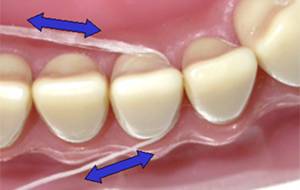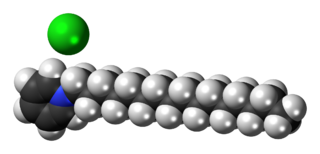
Oral-B Glide is a polytetrafluoroethylene (Teflon) dental floss manufactured by W. L. Gore and Associates exclusively for Procter & Gamble.

Oral-B Glide is a polytetrafluoroethylene (Teflon) dental floss manufactured by W. L. Gore and Associates exclusively for Procter & Gamble.
The origin of Glide (which is what the brand was called prior to the P&G acquisition) dates to 1971, when Bill Gore first used a Gore-Tex fiber to floss his own teeth; [1] Gore-Tex was the PTFE-based fiber he had invented as a "waterproof laminate". The company failed to market the product for more than three decades. Ultimately, it succeeded by marketing to dentists rather than selling the floss as a consumer product. It was widely adopted, and grew to be the #1 brand of floss in dental office use, and #2 floss in retail. [1]
In September 2003, Gore sold the brand to Procter & Gamble, who at the time announced its intention to brand the product under the Crest product line. [2] The terms of the sale provided that Gore would continue to manufacture and develop the product. [3] In 2010, Procter & Gamble rebranded the product as Oral-B Glide.
In 2006, Crest Glide was the second-ranked brand of dental floss in the United States, with sales (in supermarkets and drug stores) of $22 million and a market share of 18.8%, just behind Johnson & Johnson Reach. [4]
Environmentalists have recommended non-PTFE brands, discouraging the use of the environmentally unfriendly Teflon. [5] There is also a health concern given the use of perfluorooctanoic acid, a possible carcinogen, in the making of Teflon. [6] A 2019 study showed that some women who had flossed with Glide had elevated levels of perfluorohexanesulfonic acid (PFHxS) in their blood compared to non-flossers, and fluorine compounds were identified in Glide (as well as 5 other brands of floss out of 18 brands tested). [7] Procter & Gamble, however, disputes this finding. [8] "The study, led by Silent Spring Institute in collaboration with the Public Health Institute in Berkeley, CA, appears online ... in the Journal of Exposure Science & Environmental Epidemiology (JESEE), and is part of a special issue dedicated to PFAS (per- and polyfluoroalkyl substances)." [9]

Polytetrafluoroethylene (PTFE) is a synthetic fluoropolymer of tetrafluoroethylene that has numerous applications. It is one of the best-known and widely applied PFAS. The commonly known brand name of PTFE-based composition is Teflon by Chemours, a spin-off from DuPont, which originally discovered the compound in 1938.

Gore-Tex is a waterproof, breathable fabric membrane and registered trademark of W. L. Gore & Associates. Invented in 1969, Gore-Tex can repel liquid water while allowing water vapor to pass through and is designed to be a lightweight, waterproof fabric for all-weather use. It is composed of stretched polytetrafluoroethylene (PTFE), which is more commonly known by the generic trademark Teflon. The material is formally known as the generic term expanded PTFE (ePTFE).

Dental floss is a cord of thin filaments used in interdental cleaning to remove food and dental plaque from between teeth or places a toothbrush has difficulty reaching or is unable to reach. Its regular use as part of oral cleaning is designed to maintain oral health.
Crest is an American brand of toothpaste and other oral hygiene products made by American multinational Procter & Gamble (P&G) and sold worldwide. In many countries in Europe, such as Germany, Bulgaria, Serbia, Ukraine, Belarus, Russia, Poland, Hungary, Latvia, Romania, Estonia and Lithuania, it is sold as Blend-A-Med, the name of an established German toothpaste acquired by P&G in 1987. In France, Italy, Israel, Sweden, Finland, Argentina, Belgium, the Netherlands, Brazil, the United Kingdom, the Republic of Ireland, Australia, Nigeria, Greece, Uruguay and Colombia, P&G markets similar toothpaste formulations under the Oral-B brand.

Perfluorooctanoic acid is a perfluorinated carboxylic acid produced and used worldwide as an industrial surfactant in chemical processes and as a material feedstock. PFOA is considered a surfactant, or fluorosurfactant, due to its chemical structure, which consists of a perfluorinated, n-octyl "tail group" and a carboxylate "head group". The head group can be described as hydrophilic while the fluorocarbon tail is both hydrophobic and lipophobic.
SilverStone is a non-stick plastic coating made by DuPont. Released in 1976, this three-coat (primer/midcoat/topcoat) fluoropolymer system formulated with PTFE and PFA produces a more durable finish than Teflon coating.

Laundry detergent is a type of detergent used for cleaning dirty laundry (clothes). Laundry detergent is manufactured in powder and liquid form.

Fluorinated ethylene propylene (FEP) is a copolymer of hexafluoropropylene and tetrafluoroethylene. It differs from the polytetrafluoroethylene (PTFE) resins in that it is melt-processable using conventional injection molding and screw extrusion techniques. Fluorinated ethylene propylene was invented by DuPont and is sold under the brandname Teflon FEP. Other brandnames are Neoflon FEP from Daikin or Dyneon FEP from Dyneon/3M.
Gleem is an American brand of oral hygiene products, including toothpastes and electric toothbrushes, owned by the Procter & Gamble. It was introduced as a toothpaste in the United States in 1952 and discontinued in 2014. Procter & Gamble later revived Gleem toothpaste as a flavor variant of Crest toothpaste. In 2019, Procter & Gamble expanded the brand to include a line of electric toothbrushes.

W. L. Gore & Associates, Inc. is an American multinational manufacturing company specializing in products derived from fluoropolymers. It is a privately held corporation headquartered in Newark, Delaware. It is best known as the developer of waterproof, breathable Gore-Tex fabrics.

Cetylpyridinium chloride (CPC) is a cationic quaternary ammonium compound used in some types of mouthwashes, toothpastes, lozenges, throat sprays, breath sprays, and nasal sprays. It is an antiseptic that kills bacteria and other microorganisms. It has been shown to be effective in preventing dental plaque and reducing gingivitis. It has also been used as an ingredient in certain pesticides. Though one study seems to indicate cetylpyridinium chloride does not cause brown tooth stains, at least one mouthwash containing CPC as an active ingredient bears the warning label "In some cases, antimicrobial rinses may cause surface staining to teeth," following a failed class-action lawsuit brought by customers whose teeth were stained.

A non-stick surface is engineered to reduce the ability of other materials to stick to it. Non-stick cookware is a common application, where the non-stick coating allows food to brown without sticking to the pan. Non-stick is often used to refer to surfaces coated with polytetrafluoroethylene (PTFE), a well-known brand of which is Teflon. In the twenty-first century, other coatings have been marketed as non-stick, such as anodized aluminium, silica, enameled cast iron, and seasoned cookware.

The Procter & Gamble Company (P&G) is an American multinational consumer goods corporation headquartered in Cincinnati, Ohio, founded in 1837 by William Procter and James Gamble. It specializes in a wide range of personal health/consumer health, personal care and hygiene products; these products are organized into several segments including beauty; grooming; health care; fabric & home care; and baby, feminine, & family care. Before the sale of Pringles to Kellogg's, its product portfolio also included food, snacks, and beverages. P&G is incorporated in Ohio.

Per- and polyfluoroalkyl substances (PFASs) are synthetic organofluorine chemical compounds that have multiple fluorine atoms attached to an alkyl chain. An early definition, from 2011, required that they contain at least one perfluoroalkyl moiety, –CnF2n+1–. Beginning in 2021, the Organisation for Economic Co-operation and Development (OECD) expanded their terminology, stating that "PFASs are defined as fluorinated substances that contain at least one fully fluorinated methyl or methylene carbon atom (without any H/Cl/Br/I atom attached to it), i.e. with a few noted exceptions, any chemical with at least a perfluorinated methyl group (–CF3) or a perfluorinated methylene group (–CF2–) is a PFAS."

Oral-B is an American brand of oral hygiene products, including toothpastes, toothbrushes, electric toothbrushes, and mouthwashes. The brand has been in business since the invention of the Hutson toothbrush in 1950 and in Redwood City, California.

The global market for chemicals from fluorine was about US$16 billion per year as of 2006. The industry was predicted to reach 2.6 million metric tons per year by 2015. The largest market is the United States. Western Europe is the second largest. Asia Pacific is the fastest growing region of production. China in particular has experienced significant growth as a fluorochemical market and is becoming a producer of them as well. Fluorite mining was estimated in 2003 to be a $550 million industry, extracting 4.5 million tons per year.
Reach is an American brand of oral hygiene products, including toothbrushes, dental floss and mouthwash. The brand originated from Reach toothbrushes developed by DuPont in 1976.
This timeline of events related to per- and polyfluoroalkyl substances (PFASs) includes events related to the discovery, development, manufacture, marketing, uses, concerns, litigation, regulation, and legislation, involving the human-made PFASs. The timeline focuses on some perfluorinated compounds, particularly perfluorooctanoic acid (PFOA) and perfluorooctanesulfonic acid (PFOS) and on the companies that manufactured and marketed them, mainly DuPont and 3M. An example of PFAS is the fluorinated polymer polytetrafluoroethylene (PTFE), which has been produced and marketed by DuPont under its trademark Teflon. GenX chemicals and perfluorobutanesulfonic acid (PFBS) are organofluorine chemicals used as a replacement for PFOA and PFOS.